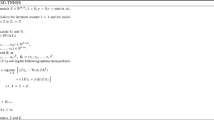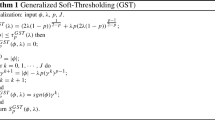Abstract
Low-rank and sparse decomposition (LRSD) has been gained considerable attention due to its success in computer vision and many other numerous fields. However, the traditional LRSD methods have the problem of the low approximation accuracy of the rank function. To deal with this problem, the truncated γ norm is used to approximate the rank function and an improved model of truncated γ norm-based low-rank and sparse decomposition (TNLRSD) is proposed in this paper. In addition, to further improve the accuracy of the proposed model, a relaxation factor is added to the classic alternating direction method of multipliers and the generalized alternating direction method of multipliers (GADMM) is presented to solve the proposed model. Finally, simulation experiments are carried out to low-rank image denoising and video foreground and background separation to verify the effectiveness and superiority of the proposed TNLRSD method. By comparing and analysing the experimental results, we can get that the proposed TNLRSD method is more effective and robust than other LRSD methods.



Similar content being viewed by others
References
Beinert R, Steidl G (2021) Robust PCA via regularized reaper with a matrix-free proximal algorithm. J Math Imaging Vis 63(5):1–24
Candes E, Li X, Ma Y, Wright J (2010) Robust principal component analysis?: recovering low-rank matrices from sparse errors. IEEE Sens Array Multichannel Sign Process Work 8(1):201–204
Cao L, Li H, Guo H, Wang B, Robust P C A (2019) For face recognition with occlusion using symmetry information. In: International conference on networking sensing and control (ICNSC), pp 323–328
Fan J, Li R (2001) Variable selection via nonconcave penalized likelihood and its oracle properties. Publ Am Stat Assoc 96(456):1348–1360
Fang E X, He B, Liu H, Yuan X (2015) Generalized alternating direction method of multipliers: new theoretical insights and applications. Math Program Comput 7(2):149–187
Feng P, Ling B W, Lei R, Chen J (2019) Singular spectral analysis-based denoising without computing singular values via augmented Lagrange multiplier algorithm. IET Signal Process 13(2):149–156
Gao C, Moore B E, Nadakuditi R R (2017) Augmented robust PCA for foreground-background separation on noisy, moving camera video. In: IEEE global conference on signal and information processing (GlobalSIP), pp 1240–1244
Hu Y, Zhang D, Ye J, Li X (2013) Fast and accurate matrix completion via truncated nuclear norm regularization. IEEE Trans Pattern Anal Mach Intell 35(9):2117–2130
Jin K, Ye J (2018) Sparse and low-rank decomposition of a Hankel structured matrix for impulse noise removal. IEEE Trans Image Process 27(3):1448–1461
Kang Z, Peng C, Cheng Q (2015) Robust PCA via nonconvex rank approximation. In: IEEE international conference on data mining, pp 211–220
Ke G, Pan Y, Yin Y, et al. (2018) Optimizing evaluation metrics for multitask learning via the alternating direction method of multipliers. IEEE Trans Cybern 48(3):993–1006
Keshavarzian R, Aghagolzadeh A, Rezaii T Y (2018) Accelerated proximal gradient method for image compressed sensing recovery using nonlocal sparsity. In: Electrical Engineering (ICEE), pp 440–445
Lin H, Wang L, Yu J, Teng Z, Dai H (2015) Nonlinear error compensation for load cells based on the optimal neural network with an augmented Lagrange multiplier. IEEE Trans Instrum Meas 64(11):2850–2862
Liu J, Rao B (2019) Robust PCA via ℓ0-ℓ1 regularization. IEEE Trans Signal Process 67(2):535–549
Liu J, He D, Zeng X, Wang M, Li W (2019) Manidec: manifold constrained low-rank and sparse decomposition. IEEE Access 7:112939–112952
Lu X, Wang W, Ma C, et al. (2019) See more, know more: unsupervised video object segmentation with co-attention siamese networks. In: Proceedings of the IEEE/CVF conference on computer vision and pattern recognition, pp 3623–3632
Lu X, Wang W, Ma C et al (2020) Learning video object segmentation from unlabeled videos. In: Proceedings of the IEEE/CVF conference on computer vision and pattern recognition, pp 8960–8970
Lu X, Wang W, Ma C et al (2020) Video object segmentation with episodic graph memory networks. In: 16th European conference on computer vision CECCV, pp 661–679
Lu X, Wang W, Ma C et al (2020) Zero-shot video object segmentation with co-attention siamese networks. IEEE Trans Pattern Anal Mach Intell 44 (4):1–15
Masuyama Y, Yatabe K, Oikawa Y (2019) Griffin-lim like phase recovery via alternating direction method of multipliers. IEEE Signal Process Lett 26 (1):184–188
Moore B E, Gao C, Nadakuditi R R (2017) Panoramic robust PCA for foreground-background separation on noisy, free-motion camera video. IEEE Trans Computat Imaging 5(2):195–211
Nie Y, Chen L, Zhu H, Du S, Tao Y, Cao X (2017) Graph-regularized tensor robust principal component analysis for hyperspectral image denoising. Appl Opt 56(22):6094
Nguyen M U, Dao T T, Tang V H (2018) Efficient depth image reconstruction using accelerated proximal gradient method. In: International conference on knowledge and systems engineering (KSE), pp 1–6
Oh T H, Tai Y W, Bazin J C, Kim H, Kweon I (2016) Partial sum minimization of singular values in robust PCA: algorithm and applications. IEEE Trans Pattern Anal Mach Intell 38(4):744–758
Recht B, Fazel M, Parrilo P A (2010) Guaranteed minimum-rank solutions of linear matrix equations via nuclear norm minimization. SIAM Rev 52 (3):471–501
Tang G, Nehorai A (2011) Robust principal component analysis based on low-rank and block-sparse matrix decomposition CISS
Wang J, Song W (2017) An algorithm twisted from generalized ADMM for multi-block separable convex minimization models. J Comput Appl Math 309(1):342–358
Wang S, Wang Y, Chen Y, Pan P, Sun Z, He G, Robust P C A (2018) Using matrix factorization for background/foreground separation. IEEE Access 6:18945–18953
Wang H, Li Y, Cen Y, He Z, Zhang L (2020) Multi-matrices low-rank decomposition with structural smoothness for image denoising. IEEE Trans Circ Syst Video Technol 30(2):349–361
Wang J, Xu G, Li C, Wang Z, Yan F (2021) Surface defects detection using non-convex total variation regularized RPCA with kernelization. IEEE Trans Instrum Meas 70:1–13
Wen F, Ying R, Liu P, Qiu R (2020) Robust PCA using generalized nonconvex regularization. IEEE Trans Circ Syst Video Technol 30(6):1497–1510
Xiao Y, Chen L, Li D (2018) A generalized alternating direction method of multipliers with semi-proximal terms for convex composite conic programming. Math Program Comput 10(4):533–555
Xie T, Li S, Sun B (2020) Hyperspectral images denoising via nonconvex regularized low-rank and sparse matrix decomposition. IEEE Trans Image Process 29:44–56
Yang Z, Yang Z, Han D (2018) Alternating direction method of multipliers for sparse and low-rank decomposition based on nonconvex nonsmooth weighted nuclear norm. IEEE Access 6(1):56945–56953
Yang Z, Fan L, Yang Y, Yang Z, Gui G (2019) Generalized singular value thresholding operator based nonconvex low-rank and sparse decomposition for moving object detection. J Frankl Inst 356(16):10138–10154
Yang Z, Fan L, Yang Y, Yang Z, Gui G (2020) Generalized nuclear norm and Laplacian scale mixture based low-rank and sparse decomposition for video foreground-background separation. Signal Process 172:1–10
Yu Y, Yu J, Li V, Lam J (2017) Low-rank singular value thresholding for recovering missing air quality data. In: IEEE international conference on big data, pp 508–513
Zhang Y, Guo J, Li C (2018) Image compressed sensing based on non-convex low-rank approximation. Multimed Tools Appl 77(10):12853–12869
Zhao L, Hou X, Yang H, Li J (2019) GRPCA21 for recovering a corrupted low-rank matrix. Int J Mach Learn Cybern 11(6):1–13
Zhou Y, Dou Y (2018) Double weighted RPCA denoising algorithm for color images. In: IEEE 4th international conference on computer and communications (ICCC), vol 2018, pp 1670–1674
Zhou Z, Li X, Wright J, et al. (2010) Stable principal component pursuit. In: IEEE ISIT proceedings, pp 1518–1522
Zhuang L, Bioucas-Dias J M (2018) Fast hyperspectral image denoising and inpainting based on low-rank and sparse representations. IEEE J Sel Top Appl Earth Observ Remote Sens 11(3):730–742
Acknowledgments
This work is sponsored by the National Natural Science Foundation of China (Nos.61501251, 62071242), the China Postdoctoral Science Foundation (No.2018M632326), the Open Research Fund of Key Lab of Broadband Wireless Communication and Sensor Network Technology (No.JZNY202113), the Natural Science Foundation of the Jiangsu Higher Education Institutions of China (No.19KJB510044), and the NUPTSF (No.NY220207).
Author information
Authors and Affiliations
Corresponding authors
Additional information
Publisher’s note
Springer Nature remains neutral with regard to jurisdictional claims in published maps and institutional affiliations.
Rights and permissions
About this article
Cite this article
Yang, Z., Yang, Y., Fan, L. et al. Truncated γ norm-based low-rank and sparse decomposition. Multimed Tools Appl 81, 38279–38295 (2022). https://doi.org/10.1007/s11042-022-12509-8
Received:
Revised:
Accepted:
Published:
Issue Date:
DOI: https://doi.org/10.1007/s11042-022-12509-8




